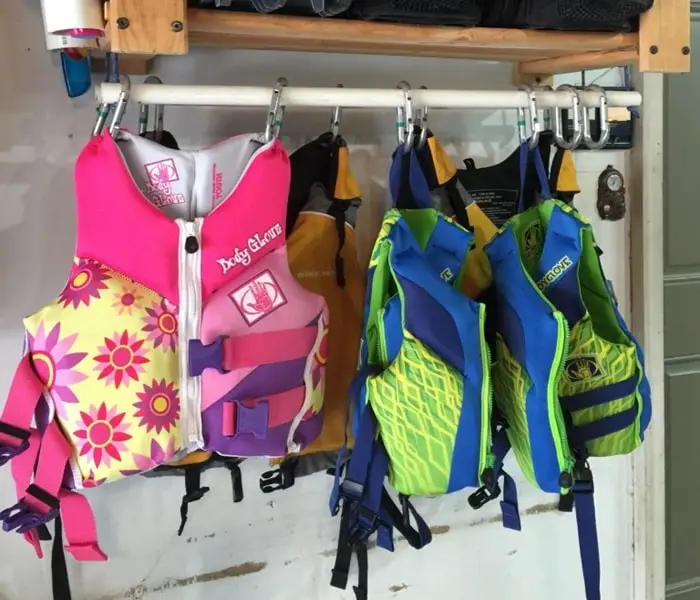Ever wondered if a life jacket, that we entrust our lives with, has an expiration date? If so, then you might ask how often do you replace a life jacket.
Well look no further, here is a complete guide on this vital equipment that saves hundreds of lives every year.
Here’s Your Complete Life Jacket Replacement Guide
A life jacket widely used PFD(Personal Flotation Device) just like the name suggests is your savior whenever you are planning to take a trip near water. So it becomes utterly essential to plan periodic maintenance of the device as well as take proper care of it.
Types Of Life Jackets
Before going into the details, let’s first understand the type of life jackets available. Buoyancy is the main criterion that separates one life jacket from another. There are several buoyancy standards. Buoyancy is the tendency of an object to float in a fluid. Life jackets use this principle to keep you floating over the water. Based on this, there are several types of life jackets available as mentioned below.
Based On Material
Inflatable

Because of their compact forms, inflatable life jackets are a popular choice for a variety of aquatic activities. They may be more comfy and easy to move into.
Inflatable PFDs(Personal Flotation Devices) differ from traditional foam PFDs in the sense that they often include a carbon dioxide cartridge that fills the life vest with air when you’re in the water. Depending on the type of inflatable PFD you have, this can be done manually or automatically.
The air or CO2 from the cartridge is what gives the PFD buoyancy, so they must be inflated for them to work properly.
Click here to check out some Life Jackets on Amazon.
Foam-Filled PFDs

When you think of a typical life jacket, you generally think of foam-filled PFDs. This type of PFD (Personal Flotation Device) is often comprised of closed-cell foam. The foam contains trapped air, and it is this trapped air that contributes to the foam’s capacity to float.
In comparison to inflatable PFDs, which must be inflated to become buoyant, foam-filled PFDs are naturally buoyant. This means that foam life jackets can be used by both children and adults because they are low-maintenance and will keep you afloat with no effort.
Based On Usage
Type I
Type I jackets provide the most buoyancy (over 20 pounds) and are particularly intended for offshore use. They’re cumbersome to wear, but they offer the distinct advantage of turning an unconscious person face-up in water.
Type II
Type II jackets are also designed to turn an unconscious person in the water face up. They have a minimum buoyancy of 15.5 pounds and are primarily used for nearshore boating excursions. Though not exactly trendy, Type II life jackets have long been popular among sailors trying to meet US Coast Guard safety criteria due to their low cost and frequently simple design.
Type III
Type III jackets provide 15.5 pounds of buoyancy as well. The comfortable, formfitting shape of these “ski vests” makes them a good choice for watersports as well as ordinary passenger use. Type III jackets usually have a front entry with a buckle or a buckle-and-zipper closure.
The catch with Type III jackets is that they are intended for conscious wearers who have a good probability of being rescued; a Type III jacket cannot ensure that an unconscious wearer will be turned face up in the water.
Type IV
Type IV personal flotation devices are known as “throwables,” and they often take the form of a ring or flat cushion that can be thrown to a person who falls into the water unexpectedly. Type IV PFDs are intended to be held onto by the user rather than worn. They have a minimum buoyancy of 16.5 pounds.
Type V
Type V jackets are multi-purpose PFDs that are frequently coupled with flotation coats, whitewater rafting vests, and even sailboard harnesses. They should only be used for the intended purpose.
Other Life Jacket Standards
The numbers 50N on buoyancy aids and 100N or 150N on life jackets indicate how buoyant they are. The ‘N’ on a life jacket represents Newton, which is a unit of force. For instance, 10 Newtons equal 1 kilogram of buoyancy. There are now four basic European buoyancy standards: 50N, 100N, 150N, and 275N.
Below, we explain briefly what each of the major buoyancy standards entails and where you may expect to see them applied.
| 50N (ISO12402-5) | A buoyancy aid rated 50N delivers at least 5kg of buoyancy. Level 50 buoyancy aids are indicated for use by proficient swimmers who are close to shore or have assistance nearby. They do not, however, have enough buoyancy to safeguard someone who is unable to aid himself. They are not intended to turn a person upside down in the water and should not be utilized in any other situation. EN 393 or ISO 12402 – 5 are applicable standards for this level. |
| 100N (ISO12402-4) | A 100N PFD has a minimum buoyancy of 10kg per lifejacket. This level of lifejacket is designed for usage in shallow, calm waters. The buoyancy of 100N is insufficient to protect a person in stormy waters, and it will not turn the user so that they are safe. This level is designed for persons who may need to wait for rescue but will most likely do so in sheltered water. The device should not be utilized in harsh environments. EN 395 or ISO 12402 – 4 are applicable standards for this level. |
| 100N (ISO12402-4) | A 150N PFD has a minimum buoyancy of 15kg per lifejacket. This is a product that is typically found for general usage along the coast and in offshore areas. A level 150 lifejacket will shift a conscious or unconscious wearer onto their back, allowing them to keep their airwaves clear and lowering the chance of drowning. The performance of 150 may be influenced by what the wearer is wearing; for example, if they are wearing heavy clothing or workwear, the buoyancy may be insufficient and they should consequently wear a higher-performing PFD. EN 396 or ISO 12402 – 3 are applicable standards for this level. |
| 150N (ISO12402-3) | A 275N PFD has a minimum buoyancy of 27.5kg per lifejacket. This is the suggested product for persons heading into extreme situations or wearing heavy PPE apparel, which may reduce the wearer’s buoyancy and the self-righting capabilities of less expensive life jackets. It is intended to keep the person floating in the proper position, with their mouth and nose clear of the surface. As a result, these are most likely to be found in the commercial and offshore industries. EN 399 or ISO 12402 – 2 are applicable standards for this level. |
How To Maintain Life Jackets?
How To Store Life Jackets?

Your life jacket should never be discarded. This is not the way to handle it. Remember that if you don’t take care of it, it won’t be able to save your life. Your life jacket should never be stored in an oily or wet environment, and it should never be put on top of something heavy. This can damage the bobbins and pins in the life jacket, and it will not be able to save you if any of these parts are lost.
When you store your life jacket with heavy items on top of it, you risk damaging or destroying important sections of the life jacket. These many systems are what hold the life jacket together, and if they are tampered with, they will no longer function, and your life jacket will no longer be able to protect you. You can either take your life jacket to a service shop and have these mechanisms replaced for you, or you can learn how to change them yourself.
When you store your life jacket with heavy items on top of it, you risk damaging or destroying important sections of the life jacket. These many systems are what hold the life jacket together, and if they are tampered with, they will no longer function, and your life jacket will no longer be able to protect you. You can either take your life jacket to a service shop and have these mechanisms replaced for you, or you can learn how to change them yourself.
How To Examine Life Jackets?
You can check your lifejacket with these easy checks as a starting point; however, this does not replace expert advice:
- Pull the straps firmly. If any of them strain or tear, discard and replace the lifejacket.
- Examine the straps for tears or cuts. If any exist, do not use the lifejacket. Replace and destroy.
- Examine the lifejacket for tears, wounds, or punctures. If there are any, discard and replace the lifejacket.
- Check to see if it floats. Consult the manufacturer or a lifejacket service center.
Approval and Expiration Of Life Jackets
Who Should A Life Jacket Be Approved By?
Your life jacket cannot be approved by some random shop dealer. The lifejacket must be certified by the Coast Guard authority of your country. Look for the stamp, as well as measurements and other important information, on the inside of the lifejacket.
Some major Coast Guard authorities,
- USGC (United States Coast Guard)
- ALGC (Australian Volunteer Coast Guard)
- RNZC (Royal New Zealand Coastguard)
- CCG (Canadian Coast Guard)
Life jackets must be Coast Guard-approved, in good working order, and the correct size for the intended user. They are most effective when worn. Children under the age of 13 must wear a Coast Guard-approved PFD when aboard a vessel unless they are below decks or in an enclosed cabin.
Do Life Jackets Expire?
You might think that these devices made of durable synthetic materials don’t expire. But you will be wrong. The material’s quality, like that of most fabrics, might decline over time. In the case of life jackets, the materials are likely to deteriorate faster the more frequently they are used or if they are not carefully cared for.
Foam life jackets typically have a 10-year lifespan. PFDs for recreational use are included. Commercial life jackets will typically need to be changed more frequently.
Inflatable life jackets frequently have an expiration date printed on the side of the air cartridge. The lifespan of your cartridge will vary, however, it is usually between 1 and 3 years. However, you should inspect the cartridge regularly to ensure that no damage or corrosion could impair its effectiveness.
When Should You Throw A PFD (Personal Flotation Device) Away?
- If the material has tears or abrasions, it is no longer buoyant.
- Buckles and strap webbing damage
- If the materials have faded or been exposed to UV light,
- If the air cartridge has reached the end of its useful life,
- Extreme temperatures are frequently exposed due to usage or inadequate storage.
- If the cloth around the foam in your life vest is frayed.
- If all or any one of the things happen, then you should replace the life jacket.
Final Words/Conclusion
If you are an enthusiastic rafter, boater, or skier, you are aware that your life jackets will be examined by your city’s park and river safety agencies. They will look for the most recent inspection of your life jacket. It is advised to replace your life jacket once every 12 months. If you have any problems with your life jacket, bring it to your local jacket supply store and they will perform any necessary repairs.
This concludes our article on How Often Do You Replace A Life Jacket? We hope you found this article helpful. Make sure to like and share this article and don’t forget to share your experience in the comment section down below.
Another survival-related post that you may like is Survive An Avalanche On A Snowmobile.
FAQs (Frequently Asked Questions)
How often do you replace a life jacket?
Life jackets last quite a long and don’t get damaged easily. Try to replace a life jacket every one or two years if you don’t use it frequently. But if you use them frequently, then replace them yearly. this is how often you replace a life jacket.
When should a life jacket be discarded and replaced?
To protect the safety of everyone on board, we recommend replacing your life jackets and PFDs every couple of years. Everything about boating is enjoyable. Don’t let anxiety and concern consume your thoughts. Replace or discard it if it losses its buoyancy, or have cuts or holes immediately.
How long does a life jacket last in the sea?
Manufacturers claim that lifejackets can last up to a decade, though this can vary depending on age and usage. They normally need to be replaced after 10 years.
What expires on a life jacket?
PFDs, life vests, and life jackets have no formal expiration dates. However, repeated use, wear and tear, and prolonged exposure to the environment render life jackets unsafe for use. The foam in traditional life jackets gradually loses its buoyancy and ability to successfully hold the head above water.
What do you do with old life jackets?
You may help bring the joy of boating to others in your community by donating gently worn life jackets. If you have a life jacket that no longer fits the people on your boat. Don’t just throw away a usable life jacket, give them to someone else.
Can you reuse a life jacket?
Inflatable life jackets are intended for single use, and a number of components must be replaced once inflated to maintain continuing usage.
Can you survive in the ocean with a life jacket?
Yes, a life jacket can keep you alive in the ocean. The floatation device will keep your head above water and will provide some sun protection. Most life vests include rations for this purpose.







